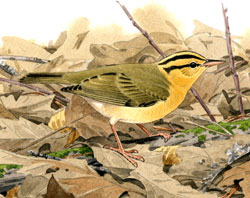Breeding Bird Atlases (BBA)
Find a Bird - BBA1
Breeding Bird Atlas 1 Species Accounts
Worm-eating Warbler
Helmitheros vermivorus
Egg Dates
June 7 to June 19
Number of Broods
one

Forbush reported the Worm-eating Warbler to be casual or a straggler in Massachusetts and a rare summer resident, locally not uncommon, in Connecticut. Nesting was first suspected in the Commonwealth when a singing male was discovered at Bash Bish Falls, Mount Washington, on June 24, 1923. Subsequently, nesting was reported from three different stations in southern Berkshire County (including from 1939 on at South Egremont), at Mount Tom, Holyoke, and several locales in the lower Connecticut River valley (1952 onward). In Worcester County, the species was rare before the 1970s but has been recorded annually since 1975. Territorial males were recorded in Uxbridge (1978), Southbridge and Petersham (1979), and Upton (1981), with breeding finally confirmed in Petersham in 1982. During subsequent years, the birds have continued to nest in Petersham and also at a station in Uxbridge. Sightings have occurred from other parts of Quabbin Reservoir away from the Petersham site. In eastern Massachusetts, breeding was first confirmed in Weston (1962) and Dover (1975). In mid-June 1981, four birds found in the Westport area were strongly suggested to be nesting.
During the Atlas period, nesting Worm-eating Warblers were confirmed at two sites in Southwick, Easthampton, Weston, and Dover. What emerges from the available information is a picture of slow increase and very gradual eastward range expansion. Despite a pattern of isolated occurrences suggested by the Atlas data, partly an artifact of the species’ low detectability, the true range in Massachusetts is probably broader. The species should be sought and expected from southern Berkshire County eastward across the lower Connecticut River valley, across Worcester County (north to Petersham and Royalston) to southern Middlesex County, central Norfolk County, and Bristol County.
The Worm-eating Warbler starts its northward migration in late March, reaches Texas and Florida in early April, and arrives at the northern fringe of its nesting range here in Massachusetts by mid-May, with individuals appearing from late April onward. As a terminal migrant, it is seldom recorded away from the nesting stations. Six records for spring transients in Worcester County range from May 2 to May 19 (TC).
Worm-eating Warblers occupy the brushy undergrowth of leaf-covered, rocky, wooded hillsides and ravines, usually near water. Advertising males deliver an unvarying and unmusical buzz, often rendered chee-e-e-e-e-e-e, which experienced observers readily distinguish from the similar sounding song of the Chipping Sparrow. Males sing while perched at 10 to 20 feet in low understory or while on the ground. In Massachusetts, some males seem to sing very infrequently, perhaps due to the absence of adjacent territorial birds. Both sexes have a loud chip call note and a softer dzt.
The nest, presumably built mainly by the female, is well concealed in the leaf litter on the forest floor, often at the base of a sapling or bush. Nest building was observed in Southwick on May 24, 1976. A nest in Weston (1962) was described as typical, lined with stems of hairy-cap moss and built on the ground beneath an overhanging Lowbush Blueberry (Smith 1964). Another nest in Petersham (1983) was approximately 5 inches in diameter and built mainly of partially decayed leaves. The inner cup was about 3 inches in diameter and contained near equal amounts of hairy-cap moss stalks and porcupine hair as well as small quills and smaller amounts of White Pine needles and fine rootlets. It was located on the ground under the lower edge of a small log on a steep slope (TC).
Clutches of three to six (typically four to five) eggs are laid in approximately the last week of May and the first week of June, based on observations of adults and young. Observed egg dates in Massachusetts have been between June 7 and June 19 (BOEM, Veit). Connecticut egg dates are May 25 to June 19 (EHF) and May 27 to June 29 (ACB). Eggs are white with brown speckles. The incubation period is about 13 days.
On June 19, 1949, a nest containing four young was discovered in South Egremont (Griscom & Snyder 1955), and on June 19, 1962, a nest in Weston contained five young (Burt, Fitzpatrick). There were still two young in this nest on June 21, and it was empty on June 24 (Smith 1964). At a nest in Petersham, adults were observed carrying food to nestlings on June 20, 1983. Young remain in the nest for about 10 days. Females disturbed at the nest perform a distraction display by fluttering over the ground. Both sexes feed the young for at least a week postfledging.
Adults feeding fledglings have been reported in Massachusetts from June 19 to July 11 (Smith 1964, TC). A molting adult feeding two large fledglings was observed on June 29 at the Petersham nest site. Fledglings calling to be fed give constant chip notes. These warblers become virtually undetectable after July, though there are scattered records through August to mid-September. The known winter range is from Venezuela to Panama and in the Bahamas and Greater Antilles east to the Virgin Islands.
Map Legend and Data Summary
Atlas 1 data collected from 1975-1979


Note: rare and local on dry deciduous hillsides; possibly increasing or previously overlooked
Thomas H. Gagnon



